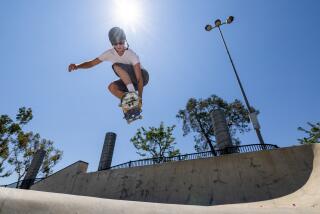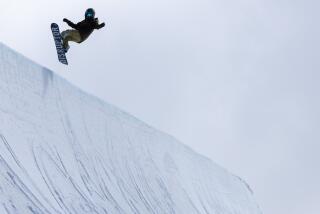Older They Are, Harder They Fall
- Share via
Since skateboarding took off in the late ‘70s, parents and pediatricians have tended to worry most about little skaters hitting the sidewalks.
Now, a new study suggests that older adolescents--aged 15 to 18--are the ones to watch. They are most likely to suffer skateboard injuries, followed by kids aged 6 to 9 and then kids aged 10 to 14, according to Dr. Robert A. Pendergrast, assistant pediatrics professor at the Medical College of Georgia.
Pendergrast researched the mishaps of 94 Baltimore skateboarders, 6 to 18 years old, and published his findings recently in the Journal of Adolescent Health Care.
“These 15- to 18-year-olds are stronger and ride with more velocity and force,” Pendergrast said. Older skateboarders take their skill for granted, added Dr. Alexander R. Lampone, medical director of the emergency department at St. John’s Hospital and Health Center, Santa Monica.
Short of banning the boards--a move Pendergrast opposes--parents and pediatricians are asking how skateboarding can be made safer. “Helmet use is most important,” Pendergrast said. “Street skateboarders don’t think about wearing helmets; it’s just not cool.” But helmets are worn at skateboarding competitions, and Pendergrast hopes the practice will soon catch on with other skateboarders as well.
A bicycle helmet works almost as well as a helmet designed specifically for skateboarding, say some doctors. (Skateboarding helmets are harder to find than bicycle helmets. One manufacturer that does make a special skateboarding helmet is Pro-Tec, (800) 338-6068. It has more padding and offers more head coverage than most bike helmets, said a spokeswoman.)
Skateboarding in a “controlled environment” such as a skateboarding park is safer than street boarding, Pendergrast added. Protective padding at knees and elbows is also advised.
Children younger than the age of 5 should never ride skateboards, warns the American Academy of Pediatrics. In a policy statement published last year in the journal Pediatrics, the academy said youngsters that age “are not developmentally prepared to protect themselves from injury.” Their high center of gravity impedes their ability to break a fall.
More to Read
Sign up for Essential California
The most important California stories and recommendations in your inbox every morning.
You may occasionally receive promotional content from the Los Angeles Times.










